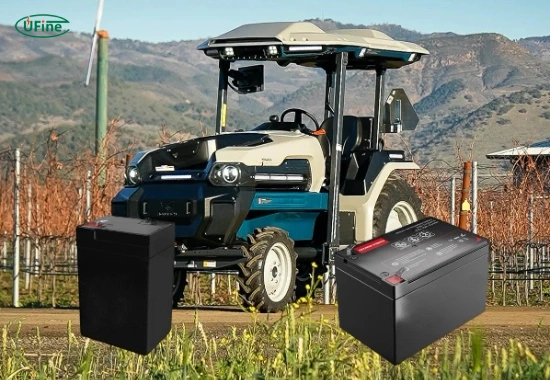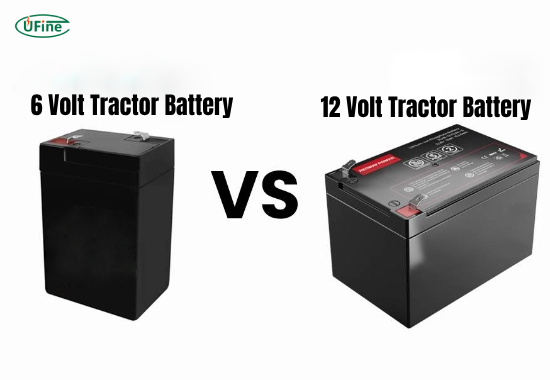
- Part 1. What is a 6-volt tractor battery?
- Part 2. What is a 12-volt tractor battery?
- Part 3. What are the main differences between 6-volt and 12-volt batteries?
- Part 4. Which tractors use 6-volt batteries?
- Part 5. Which tractors use 12-volt batteries?
- Part 6. Can you replace a 6-volt battery with a 12-volt battery?
- Part 7. Tools needed for 6V to 12V battery conversion
- Part 8. Pros and cons of 6-volt tractor batteries
- Part 9. Pros and cons of 12-volt tractor batteries
- Part 10. How to choose the right battery for your tractor?
- Part 11. FAQs about 6-volt tractor battery vs 12-volt
Which is better for your tractor, a 6-volt or 12-volt battery? The answer depends on your tractor’s age, electrical specifications, and farming needs. Choosing the correct battery can influence your tractor’s performance, durability, and safety.
This in-depth guide will help you understand the differences between 6-volt tractor batteries and 12-volt options. We will explore their history, technical distinctions, applications, and even how to convert from one to another. Whether you use a vintage machine or a modern workhorse, this guide will help you make the best decision.
Part 1. What is a 6-volt tractor battery?
A 6-volt tractor battery is a lead-acid battery that produces 6 volts of electricity. These batteries were widely used in farm tractors before the 1960s. They feature thicker plates and are designed for deep cycle usage, meaning they deliver a steady power supply over longer periods without rapidly discharging.
This type of battery is commonly found in older models like the Ford 8N, Farmall H, and John Deere Model B. These machines have simpler electrical systems and were engineered to run on lower voltage.
The 6-volt battery is larger and heavier than a 12-volt battery. It is also built to handle slow-cranking engines, which require more torque over a more extended period to start.
Part 2. What is a 12-volt tractor battery?
A 12-volt tractor battery is the modern standard in the agricultural world. These batteries are used in tractors built from the 1960s onward and are suitable for machines with more complex electrical systems. These systems often include electric starters, lights, fuel pumps, sensors, and other electronic components that require higher voltage.
12-volt batteries are known for their lightweight, high-cranking power and easy availability. They can start engines faster and perform better in cold conditions.
Modern tractors, such as those made by John Deere, Massey Ferguson, Kubota, and New Holland, typically use 12-volt batteries.
Part 3. What are the main differences between 6-volt and 12-volt batteries?
The main difference lies in their electrical output. A 6-volt battery delivers less voltage and is typically used in older tractors with simpler systems. A 12-volt battery provides double the voltage, making it suitable for modern tractors with more demanding electrical needs.
Here is a detailed comparison of their technical specifications:
| Feature | 6 Volt Battery | 12 Volt Battery |
|---|---|---|
| Voltage Output | 6 volts | 12 volts |
| Cold Cranking Amps (CCA) | 400 to 600 CCA | 600 to 1000+ CCA |
| Amp-Hour Rating | 180 to 225 Ah | 70 to 120 Ah |
| Weight | 55 to 65 pounds | 35 to 45 pounds |
| Size (L×W×H in inches) | Approximately 10.3 × 7.1 × 10.8 | Approximately 10.2 × 6.8 × 8.3 |
| Common Use Case | Pre-1960 tractors | Post-1960 tractors, modern machinery |
| System Compatibility | Positive ground systems | Negative ground systems |
| Availability | Less common, specialty stores | Widely available in farm supply centers |
| Maintenance Needs | Higher due to older technology | Lower, often maintenance-free options |
These data points show that 12-volt batteries generally offer better performance and are more convenient to maintain. However, 6-volt batteries still serve a purpose in vintage and collector tractors.
Part 4. Which tractors use 6-volt batteries?
Tractors built before the 1960s were designed to operate on 6-volt systems. Some examples include:
- Ford 8N, 9N, and 2N
- John Deere A, B, and H
- Farmall Cub and Farmall H
- Allis-Chalmers WC and WD models
- Oliver 70 and earlier models
These tractors were built with simple wiring systems that do not support the higher voltage of 12-volt batteries. Using a 12-volt battery in these systems without proper conversion can damage the starter, lights, and ignition components.
Part 5. Which tractors use 12-volt batteries?
Tractors manufactured in the mid-1960s and later were designed for 12-volt systems. These machines support various electrical components and are built for more demanding workloads.
Examples include:
- John Deere 4020, 4440, and newer models
- Massey Ferguson 135, 165, and newer
- Case IH Maxxum series
- New Holland T5 and T7 series
- Kubota M series tractors
The 12-volt system allows for faster starting, more powerful lighting, and compatibility with modern farming accessories.
Part 6. Can you replace a 6-volt battery with a 12-volt battery?
It is possible to replace a 6-volt battery with a 12-volt one, but this requires a complete system conversion. Dropping in a 12-volt battery without modifying the electrical components can cause severe damage.
To convert safely, you need to address the following:
- Replace bulbs with 12V-rated equivalents.
- Install a 12V voltage regulator.
- Upgrade the ignition coil and resistor.
- Ensure the starter motor can handle 12V, or replace it.
- Convert the system to negative ground if it was originally positive ground.
This process is not overly complicated but requires attention to detail. Many owners of vintage tractors choose to convert for better performance, especially in cold climates.
Part 7. Tools needed for 6V to 12V battery conversion
If you plan to convert your tractor from a 6-volt system to a 12-volt system, you will need the following tools and equipment:
- Socket set and wrenches
- Wire strippers and crimpers
- Multimeter to check voltage and continuity
- Screwdrivers (flathead and Phillips)
- 12V voltage regulator
- 12V battery
- 12V light bulbs (headlights and dash lights)
- Ballast resistor or 12V ignition coil with internal resistor
- Electrical tape or heat shrink tubing
- New battery cables (heavier gauge for 12V)
- Starter solenoid (if replacing a mechanical switch)
Having these tools ready will make the conversion process smoother and safer. Always disconnect the battery before working on electrical systems.
Part 8. Pros and cons of 6-volt tractor batteries
Advantages of 6-volt batteries:
- Explicitly designed for vintage tractors
- Provide strong torque for slow-cranking engines
- Maintain historical accuracy for restorations
Disadvantages of 6-volt batteries:
- Harder to find in stores
- Heavier and bulkier
- Slower cranking speed in cold weather
- Require more frequent maintenance
Part 9. Pros and cons of 12-volt tractor batteries
Advantages of 12-volt batteries:
- Faster engine starts
- Easier to find and replace
- Better cold weather performance
- Supports more electrical accessories
Disadvantages of 12-volt batteries:
- It can damage 6V systems if not converted properly
- It may not be ideal for historical restorations
- Requires careful setup when used in older tractors
Part 10. How to choose the right battery for your tractor?
Choosing the correct battery depends on several key factors:
- Tractor model and year: Check your owner’s manual or service manual.
- Electrical system type: Is your system 6V or 12V?
- Starting needs: Cold climates may need higher cranking amps.
- Originality vs practicality: Are you restoring or using the tractor daily?
- Maintenance preferences: 6V batteries may require more attention.
A 12-volt system will likely give you more reliability if your tractor is a daily workhorse. Staying with the original 6-volt setup may be best if it is a collector’s item.
Part 11. FAQs about 6-volt tractor battery vs 12-volt
Can I jump-start a 6-volt tractor with a 12-volt battery?
No. Doing so can damage the electrical system. Always use the correct voltage when jump-starting.
Are 6-volt batteries still being manufactured?
Yes. Several specialty manufacturers still produce 6-volt batteries for vintage tractors and classic cars.
Why does my 6-volt battery keep losing charge?
Possible reasons include old age, poor ground connections, a faulty generator or regulator, or parasitic electrical drains. Regular maintenance and a multimeter check can help diagnose the issue.
Can I use two 6-volt batteries to make 12 volts?
Yes. Connecting two 6-volt batteries in series (the positive terminal of one to the negative of the other) will create a 12-volt power source. This is commonly done in RVs and heavy-duty equipment.
What is the best battery type for winter use?
A 12-volt battery with a high Cold Cranking Amps (CCA) rating is best for cold weather. Look for a battery with at least 800 CCA for reliable winter starts.
Related Tags:
More Articles

Which LiPo Charger Balancer Is Best for Your Battery?
Understand why balancing is essential for multi-cell LiPo charging. Prevent swelling, extend lifespan, and choose the right LiPo balancer.
Can You Replace a 7.2v Nimh Battery and Charger with a Lithium System?
Upgrade 7.2V NiMH to lithium? Learn risks, safety checks, runtime gains, charging changes, and when the upgrade makes financial sense for RC, tools, devices.
Which Bike Battery is Best for a 250W Commuter E-Bike?
Learn how to choose the best battery for your 250W commuter e-bike. Compare sizes, chemistry, and performance for optimal daily use.
7.2V Battery and Charger Pricing Guide: What Affects Cost in 2025?
Discover why 7.2V battery and charger prices vary in 2025. Learn key cost factors beyond voltage and mAh to avoid overpaying.
AED Battery Guide: How to Choose, Maintain, and Replace Your AED Battery
A complete guide to AED batteries: types, standards, backup battery needs, disposal, and expert tips for safe, long-lasting AED performance.




